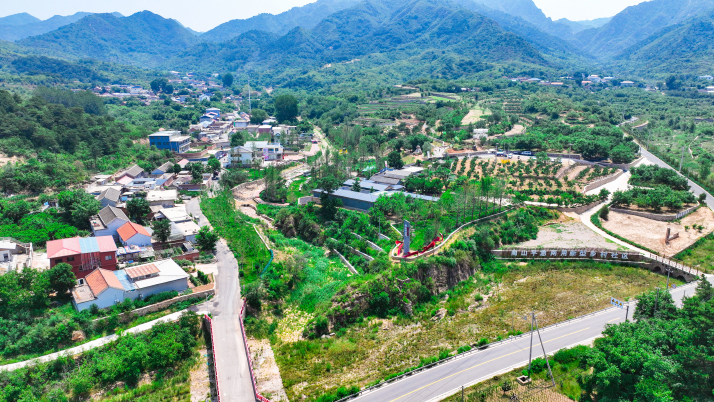| China |
| Empowering rural revitalization with art | |
|
|
 A panoramic view of the Nanshan Village in Pinggu District of Beijing (COURTESY PHOTO)
It is hard to imagine that, just one year ago, Meng Chao was teaching at Tsinghua University. Today, he is a leader of a village in northwest Beijing.
Some 70 km from downtown Beijing, Nanshan Village, located in Nandulehe Town, Pinggu District, sits in a 3-km-long lush valley in which a river quietly flows. Beyond one of the mountains behind the village is Beijing's neighboring Tianjin Municipality. "Like many northern mountain villages, Nanshan once struggled to fund infrastructure. The roads were rough and the prices of locally produced persimmons, walnuts, and hawthorns declined year after year," Jia Jingyu, an official from the township government, told Beijing Review. Young people left to work elsewhere, leaving many homesteads quiet and empty, he added. Decreasing prices of rural produce and the resulting departure of young people are development dilemmas faced by many traditional rural areas in the north. Nanshan, spanning 14.6 square km, has 735 households, with the average age of its residents being about 68. Some traditional industries have failed to increase villagers' incomes and lead them to prosperity. In an extreme case, during a household survey, officials found an elderly lady earned only about 2,000 yuan ($280) in a year from 200 walnut trees. "Moreover, it's not safe for the elderly to climb the mountains to pick walnuts," Jia said. Relying solely on farming cannot solve the income problem, which has led to the outflow of young people and the hollowing out of the village. Without people to engage in rural industries, incomes remain low, creating a vicious cycle. Nanshan, in need of a radical change to break free from the cycle, turned to art as a means of revitalization. The transformation began after the village contacted Tsinghua University. Back then, Meng was a teacher with the Academy of Art and Design of Tsinghua. His research focused on land art and rural revitalization, as well as the empowerment of cultural industries. He was eager to go into the field to put theories into practice. "We should integrate artistic elements into urban and rural construction, and meet people's need for a better life with art," Meng said. The village is tranquil, suitable for developing art-themed leisure tourism, he added. Meng has not only moved to Nanshan but also assumed the position of First Secretary of the Communist Party of China (CPC) Nanshan Village Branch, contributing to the village's development with art. First secretaries are usually selected and dispatched to villages by CPC committees at higher levels, and are part of the village leadership. "The beauty of Nanshan is refreshing," Meng said, adding bringing artistic features to the village enhances rural aesthetics. In July, Nanshan and Tsinghua jointly organized Nanshan Art Season, attracting eight art colleges and universities from Beijing, Tianjin, and Hebei Province, with over 100 teachers and students descending upon the village to create art. Together they produced more than 30 artworks, depicting rural scenery and life, with their works to be displayed in the village's homestays. Through land and property leasing and transfers, the village has renovated private homes and collective land, built boutique homestays, and improved public service facilities. Currently, more than 30 boutique homestays are in operation. Over the previous two days in mid-October, Liu Wei, an engineering designer, had been exploring Nanshan with some friends. He said he adores the serene environment in the village. "Some villages suffer from severe homogenization," Liu said. "But the cultural characteristics here are particularly appealing." "Rural areas aren't just about agriculture and the future rural areas won't just be about farming," Jia said. In his view, art and culture inject soul into the village's development. After attracting people through art, it's necessary to develop industries, enabling residents to prosper economically, Meng added. (Printed edition title: Immersed in Art) Copyedited by G.P. Wilson Comments to taozihui@cicgamericas.com |
|
||||||||||||||||||||||||||||||
|